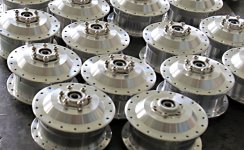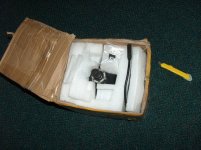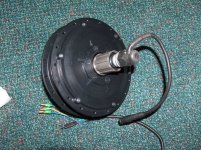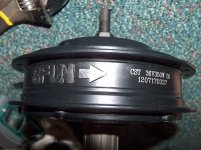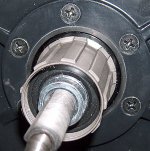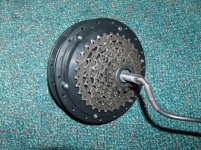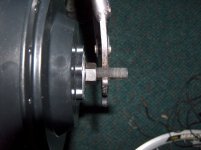In December 2012, we received six CST motors from Bafang to test (we did pay for them, but the factory did cooperate in providing variations for testing). Five went to Wellington, one stayed in Auckland. I kept the Auckland 300W, 36v 12T, installed on a 700c rim. In January I visited the Bafang factory in Suzhou, China and brought back a 14T motor with the same configuration as the one kept in Auckland. Note that normally the motors are either 250W for the Euro (and now Australia) market, the 350W are for the USA and other less restrictive market, but NZ splits the difference with 300W, so Bafang set up ours for the NZ standard. We are working with them to offer the NZ-legal model as a kit that will have features appropriate for our hilly market (high windings, higher Amp controllers, more torque). All motors are being run on 36V batteries, which we deem appropriate for those who ride on the road and want to comply with the law.
The Wellington guy reports the CST is a better built motor than the older Bafang BPM. I cannot comment, having never tried the BPM, but I found the CST to be very smooth, very quiet, and it moves a Montague Crosstown bike with a 180 lb rider up a 20-degree, reasonably-long hill very comfortably with pedalling... about the same effort pedalling as on the flat without a motor. It is a nice motor, and in examining at how it is assembled at the factory, I noted that the winding is now done high-production by machines, which means they should be more reliable than the early days when workers wound motors by hand. China's manufacturing is changing, just like "Made in Japan" in the 1960's meant junk, but by the 1980's meant better than Chrysler and RCA, and in the case of Nikon, equal to Leica. The CST seems to be better because of better Chinese manufacturing standards.
On the Montague we also installed Bafang's S530 BB sensor, a 32 pulse per cycle pedal sensor that is much faster and smoother than the usual 8 pulse pedal sensor that clips on the pedal crank. The BB sensor replaces the bottom bracket (if you order one, ask me how to install it, it's a bit sensitive right now, although Bafang is aware of this and may come out with a revision). Almost immediately it sends power to the motor when one begins to pedal. We also added a thumb throttle and a C910 display with three power modes. We tried the K1200 controller that bolts on the luggage rack in line with the battery, and the Z01 that straps on the frame with zip ties and Z02 controller that is the smallest and we put in a Brooks seat bag. The stock controllers are set to 15A which is inadequate for the 20 degree test hill, so Bafang provided us with a 22A K1200 and a 25A Z01. The 22A is sufficient. When we removed the 12T motor and replaced it with the 14T, we did not notice a difference, both do the job. Note the high windings on a 700C motor are to give torque up hills which is more important than higher top speed. At present, the thumb throttle is keyed to the C910 display, which is designed to control the S530 sensor. What this means that if the C910 is set to low power (settings are 0-1-2-3), the thumb only gives that power (and if the mode is set to zero, the thumb does not work). We have suggested to Bafang to make the thumb throttle independent of the mode setting because it is needed to override. You are at a stop and suddenly there is a bus/truck/car barrelling down on you and you need to get out of the way. Pressing the mode button twice to go from 1 to 3, then hitting the thumb throttle means you are dead meat. Mashing the thumb throttle to get full power just might save you. Bafang is looking at this now. We also are suggesting that for thumb guys, a cruise control feature is important. Since much of their market was Europe, this had not been something they provided. We should get a test unit in a few weeks.
The Wellington guy wanted to go the simple route. His Z01 controllers came with nothing but a thumb throttle and wires to the battery and motor. Less to go wrong. We tried it that way and it works fine, although after a while holding the throttle down can get tiring. Also, it is live all the time, unless you install a power switch (high Amp) between the controller and the battery. It does not have an ebrake kill switch either, which means the only way to cut the motor is to let off the thumb throttle. I worry what might happen if the thumb throttle were to stick in the on position. In any case, Bafang can offer the Z01 with or without the extras, my advice is at least have a kill switch on the handle bar, if not an ebrake kill function.
Note that much of this advice will pertain more to someone who wants to go into the business of ebikes. If you want to buy 300 motors a year, or 40,000, then you go to Bafang and give them your specifications. If you are buying one for yourself, you must take what their dealers have on offer. The beauty of the CST kit is that it can convert a wide range of pedal bikes, especially MTB models, to ebikes that look professional. Choose a bottle battery or rack battery, also supplied by them as part of the kit, and you should have a superior bike to most pre-made ebikes where the frames are either too long (because they stick the battery behind the seat post, adding 4" to the length) or the frames look like anaemic mopeds. For small bike shops in big cities who want to get into the business of offering ebikes, the CST kit is a good way to go. If you want to contact Bafang, PM me and I will make the introduction to the right guy to speak with.
So, bottom line. I own it, I like it, and I think it is a good motor, especially for the person who is not a tinkerer. The old joke about computers says that Apple is Catholic (you do it their way) while Microsoft is Protestant (you figure it out on your own). Bafang is like Apple. The controllers cannot be reprogrammed except by the factory. They listen to the market (as the first poster on this thread demonstrated... he suggested the cassette idea and they did it), but once you get it, it will only work the way they intend. Of course, you can run the CST with someone else's controller. We tried it with an Infineon from CellMan and it worked fine that way as well. Actually, the Montague looks ridiculous right now as it has three thumb throttles, two displays, two speed choice buttons, three controllers and tons of wires all over the place, but that's the joy of testing.
BTW, we are a charitable trust whose mission in this area is to get more people on bicycles, and so far, the cost of testing ebike motors has exceeded the revenue, since there is none except donations. PM me if you want to make a donation... tax deductible in the USA or NZ.
